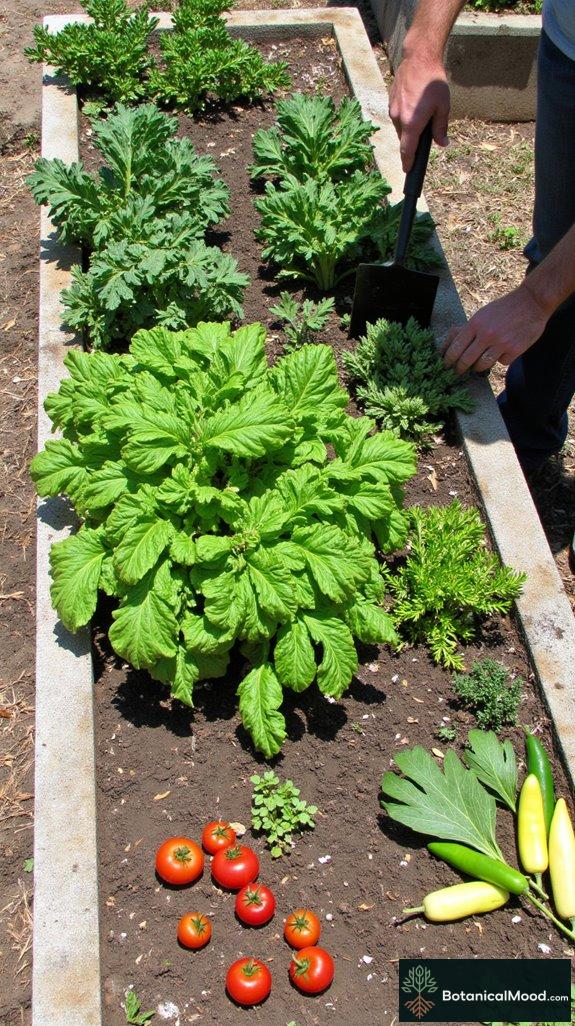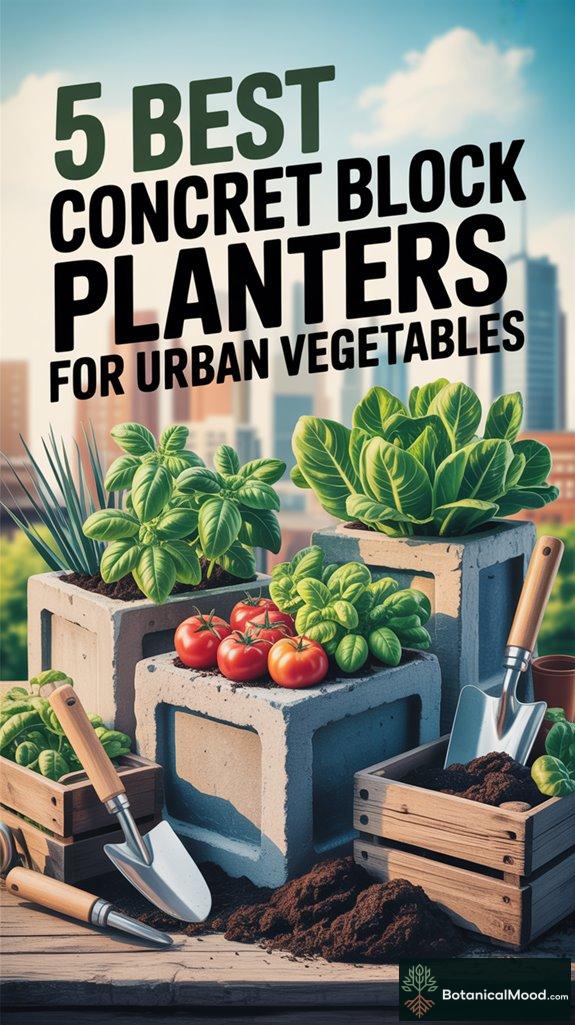If you want to grow vegetables in the urban jungle, let me tell you about my concrete block planter adventure. It’s like a superhero but for your garden.
I dabbled with EcoBlocks—super sturdy!
Then came the perfect Garden Wall Blocks, letting me unleash my inner designer. Who knew I had it in me?
Pier Blocks were a game changer for sturdy roots; they practically begged me to plant more.
And those Stackable Planters? Talk about height envy!
Just remember drainage—even plants want a spa day.
So, are you ready to embrace this concrete utopia for your veggies?
Bringing Harmony Through Concrete Block Garden Design
Once, I squished my tiny city garden into a compact corner, and boy, did I learn the hard way about design layout. I mixed up my tomatoes and peppers—oops! The stackable planters made me rethink height, ensuring sunlight reached every leafy green.
So, I added decorative stones for flair and drainage purposes, too.
Now, it’s not just a garden; it’s a veggie playground. I realized how vital garden design is—just like picking the right outfit for a date. You want to impress from the very first glance!
Quick Takeaways
- Durable concrete block planters support robust urban vegetable gardening, providing adequate drainage and preventing root rot.
- Optimal dimensions of 3-4 feet in length and 1-2 feet in width ensure ample space for root growth.
- Incorporate companion planting to maximize yields and deter pests, enhancing overall vegetable health.
- Utilize vertical gardening techniques in planters to save space and increase plant density for urban gardens.
- Choose suitable vegetables like bush tomatoes, peppers, and herbs for compatibility and diversity in planter arrangements.
Choosing the Right Block Size for Your Garden

Concrete block planters are robust, customizable planting beds, ideal for urban gardens with limited space. These planters come in standard sizes of 4’x2’x1’ or larger modular configurations, providing ample room for root growth.
Constructed using hollow concrete blocks, they create a sturdy frame that retains soil, moisture, and nutrients while allowing for proper drainage when filled with quality potting mix. Arranging blocks in a staggered pattern not only enhances aesthetics but also creates microhabitats for beneficial insects, fostering a healthier ecosystem that supports plant growth.
Suitable plants for these beds include vegetables like tomatoes, peppers, and leafy greens, as well as herbs like basil and parsley.
Effective Bed Designs for Urban Spaces

Concrete block planters are an innovative solution for urban gardening, ideal for limited spaces. Typically, these planters measure 3-4 feet in length and 1-2 feet in width, with a height that can vary between 12-24 inches.
Arranging blocks in a square or rectangular layout creates an appealing focal point while maximizing planting area. Constructed using sturdy concrete blocks, these beds are weather resistant and environmentally friendly. Fill them with nutrient-rich soil to grow a variety of vegetables, such as tomatoes, peppers, and herbs. Additionally, customizing your planter design enhances both functionality and aesthetics, allowing you to transform your space easily.
Arranging concrete blocks in a cohesive layout not only enhances aesthetics but also optimizes your planting area for a bountiful harvest.
Selecting Plants for Concrete Block Planters
Choose Plants Wisely
When selecting plants for concrete block planters, consider their space and sunlight requirements. Here’s a list of suitable vegetables:
- Bush Tomatoes
- Leafy Greens (like spinach)
- Radishes
- Herbs (basil, mint)
- Peppers
Designing Your Concrete Block Planter
Design Tips for Planting Bed
To create a productive planter, follow these tips:
- Sketch your layout before planting, ensuring adequate sunlight exposure.
- Space taller plants like tomatoes at the back and shorter plants (like basil) at the front.
- Aim for a density of 1-2 plants per block space for best growth.
- Consider companion planting to improve yields and deter pests.
Sustainable Urban Gardening Practices
Implementing sustainable gardening practices, such as composting kitchen scraps or collecting rainwater for irrigation, can enhance your urban gardening efforts.
Utilizing organic fertilizers will promote healthy plant growth, while maintaining biodiversity with pollinator-friendly flowers is a must. Embrace eco-friendly methods to nurture your garden.
Essential Filling Materials for Stability

Concrete block planters are sturdy, versatile beds ideal for urban gardening. Typically sized at 4×4 feet or larger, they’re constructed using stackable concrete blocks arranged in a square or rectangle. The planters can fill with essential materials like gravel for drainage, soil, and compost for nutrient-rich planting environments. Modular herb beds can enhance the planting experience by enabling diverse arrangements tailored to specific herbs and vegetables.
Ideal for vegetables, these beds provide great accessibility and stability. A well-constructed planter can feature decorative options such as paint or a stone finish, enhancing the urban environment.
Selecting Plants for Concrete Block Planters
When selecting plants, consider sunlight, space, and growth habits. Recommended plants include:
- Herbs: Basil, Chives, Mint
- Leafy Greens: Spinach, Kale, Lettuce
- Compact Vegetables: Radishes, Carrots, Bush Beans
Designing Your Concrete Block Planter
To design a successful concrete block planter, follow these tips:
- Choose a sunny location with at least 6 hours of sunlight daily.
- Use quality soil mixed with organic matter for nutrition.
- Space plants adequately; leafy greens can be 6 inches apart, while bush beans need about 12 inches.
- Incorporate companion planting to improve growth rates and deter pests.
Pro Tip: Use a grid system to visually plan out plant arrangements before planting!
Exploring Urban Gardening Techniques
Urban gardening techniques involve vertical planting, container gardening, and organic practices. These methods maximize space, improve yield, and foster sustainability.
Whether using roofs, balconies, or community spaces, thoughtful arrangements and plant choices can create vibrant green areas in dense locations.
Enhancing Aesthetics With Wood and Finishes

Concrete block planters are versatile planting beds that seamlessly blend modern aesthetics with urban gardening. Typically sized at 4×4 feet, these planters can be arranged in various configurations to suit your space. Constructed using durable concrete blocks, they can be enhanced with wood finishes for warmth and character. Additionally, incorporating cinder block modular beds allows for an adaptable approach to garden design.
Concrete block planters combine modern design with functionality, perfect for urban gardening in adaptable 4×4 configurations.
Ideal for vegetables like tomatoes, peppers, and herbs, the layout allows for maximum sunlight exposure and drainage. To construct, simply stack the blocks to create a square or rectangular design, filling the interior with rich soil.
Choosing Vegetables for Concrete Planters
When selecting plants, consider sun exposure and growth habits. Ideal choices include:
- Tomatoes
- Basil
- Lettuce
- Peppers
- Carrots
These plants thrive in compact spaces while providing a bountiful harvest.
Designing Your Concrete Planter
To design an effective concrete planter, follow these tips:
- Initial Planning: Sketch your garden layout.
- Plant Arrangement: Use taller plants in the center or back for visibility.
- Spacing: Verify adequate space (12-18 inches) between each plant to allow for growth.
Pro tip: Incorporate companion planting to maximize space and pest control!
Exploring Urban Gardening Trends
Urban gardening trends are progressing, focusing on sustainability and space efficiency. Growing vertical gardens or utilizing rooftop spaces is gaining popularity.
Consider integrating hydroponics for efficient, soilless growth. This innovative approach can transform limited urban areas into vibrant green spaces.
Maintenance Tips for Long-lasting Planters

Concrete block planters are a durable and adaptable solution for urban gardening. They’re typically constructed using standard concrete masonry blocks arranged in a rectangular shape, allowing flexibility in size—commonly 4-6 feet long and 2-3 feet wide.
The rough texture provides a unique aesthetic while accommodating various plants such as herbs, vegetables, and flowers. Drainage holes can be incorporated to prevent root rot, and soil is layered for ideal growth, with the addition of nutrients to promote healthy plant development. Additionally, implementing drainage techniques is crucial to ensure the longevity of your planter.
How to Select Plants for Your Planter Bed
Choosing the right plants is essential for successful gardening. Consider these options:
- Tomatoes
- Lettuce
- Basil
- Peppers
- Spinach
Opt for companion plants that thrive together and guarantee a mix of heights for visual appeal.
Designing Your Concrete Planter Bed
To expertly design your planter bed, follow these tips:
- Sketch a layout before construction.
- Group plants with similar sun and water needs.
- Space taller plants like tomatoes behind shorter plants like basil.
Pro tip: Use a mix of crops with staggered harvesting times to maximize yield throughout the growing season.
Exploring Urban Gardening Techniques
Urban gardening techniques include vertical gardening, hydroponics, and square foot gardening, which suit limited spaces.
Incorporating these methods can enhance your planting efforts while making the most of urban environments.
Plant Bed Upkeep Throughout Year

Keeping your planter bed healthy throughout the year requires a steady commitment and an understanding of the seasonal needs of your plants.
To maintain a thriving planter bed, understanding seasonal needs and committing to consistent care is essential.
I focus on seasonal planting to guarantee that each crop thrives during its prime growing period, rotating varieties like Solanum lycopersicum (tomatoes) and Brassica oleracea (kale) to maximize yield.
Pest management is essential, too; I regularly inspect for common pests and employ organic solutions, such as neem oil, to protect my harvest.
Regular watering, mulching with organic compost, and pruning spent plants keep my beds vibrant. Additionally, using straw bale gardening can enhance soil health and provide stable growing conditions throughout the season.
Summary
I love creating my own concrete block planters for urban gardening. They make it easy to grow vegetables on my balcony. With the right design and a little maintenance, I can enjoy fresh produce while making the most of my small space.
I’d love to hear about your own gardening experiences. What tips do you have?
Feel free to share photos of your garden and tell me how you designed your space!
References
- https://olivegreyavenue.com/diy-raised-garden-bed/
- https://abundantminigardens.com/how-to-create-an-awesome-raised-garden-bed/
- https://www.youtube.com/watch?v=DNLfHO99DPE
- https://www.youtube.com/watch?v=nj_MSCEx5uo
- https://permies.com/t/193823/Quikrete-concrete-raised-bed-construction
- https://www.homedepot.com/b/Outdoors-Garden-Center-Raised-Garden-Beds/Concrete/N-5yc1vZbx7cZ1z0uet8

Leave a Reply